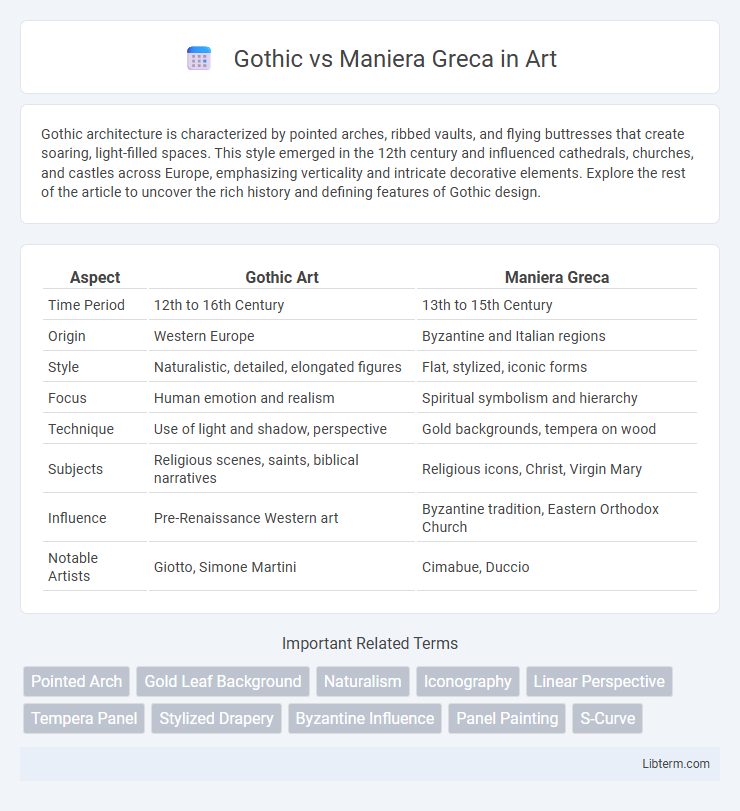Gothic architecture is characterized by pointed arches, ribbed vaults, and flying buttresses that create soaring, light-filled spaces. This style emerged in the 12th century and influenced cathedrals, churches, and castles across Europe, emphasizing verticality and intricate decorative elements. Explore the rest of the article to uncover the rich history and defining features of Gothic design.
Table of Comparison
| Aspect | Gothic Art | Maniera Greca |
|---|---|---|
| Time Period | 12th to 16th Century | 13th to 15th Century |
| Origin | Western Europe | Byzantine and Italian regions |
| Style | Naturalistic, detailed, elongated figures | Flat, stylized, iconic forms |
| Focus | Human emotion and realism | Spiritual symbolism and hierarchy |
| Technique | Use of light and shadow, perspective | Gold backgrounds, tempera on wood |
| Subjects | Religious scenes, saints, biblical narratives | Religious icons, Christ, Virgin Mary |
| Influence | Pre-Renaissance Western art | Byzantine tradition, Eastern Orthodox Church |
| Notable Artists | Giotto, Simone Martini | Cimabue, Duccio |
Introduction to Gothic and Maniera Greca Styles
Gothic style, prominent from the 12th to the 16th century in Europe, emphasizes naturalism, intricate details, and elongated figures with emotional expression, often seen in stained glass and illuminated manuscripts. Maniera Greca, rooted in Byzantine art and prevalent in the 13th and 14th centuries, features flat, iconic representations with gold backgrounds, strong outlines, and a lack of perspective to convey spiritual symbolism. Both styles reflect distinct cultural and religious influences, shaping medieval visual narratives through their unique approaches to form and composition.
Historical Origins and Development
The Gothic style, emerging in 12th-century France, evolved through the High and Late Middle Ages emphasizing verticality, light, and intricate ornamentation, primarily seen in cathedrals and religious art. Maniera Greca, rooted in Byzantine traditions, developed in the 13th and 14th centuries in Italy, characterized by iconic religious imagery, gold backgrounds, and flat, stylized figures, reflecting Eastern Orthodox influences. Both styles represent distinct artistic lineages shaped by regional religious and cultural dynamics, with Gothic linked to Western European medieval Christianity and Maniera Greca to Byzantine ecclesiastical heritage.
Key Characteristics of Gothic Art
Gothic art is characterized by its emphasis on verticality, intricate details, and naturalistic forms, often seen in pointed arches, ribbed vaults, and stained glass windows. It features elongated figures with expressive faces, rich color palettes, and a strong narrative element that conveys religious themes with emotional intensity. Compared to Maniera Greca, which retains Byzantine stylization and flat, symbolic forms, Gothic art advances toward realism and spatial depth, reflecting a transition toward humanism in medieval Europe.
Defining Features of Maniera Greca
Maniera Greca is characterized by its use of gold backgrounds, flat and elongated figures, and a strong emphasis on spiritual symbolism rather than naturalism. This Byzantine-influenced style features rigid, frontal poses and a lack of perspective, contrasting with the more naturalistic and detailed facial expressions common in Gothic art. The technique prioritizes spiritual representation through stylized forms, rich colors, and intricate patterns that convey religious themes.
Influences and Inspirations
Gothic art drew heavily from medieval European religious themes, incorporating elongated figures and intricate details inspired by illuminated manuscripts and architectural elements such as pointed arches and stained glass windows. Maniera Greca, rooted in Byzantine traditions, emphasized spiritual symbolism, characterized by flat, frontal figures with gold backgrounds influenced by Eastern Orthodox iconography. While Gothic art sought emotional expression through naturalism, Maniera Greca maintained a stylized, abstract approach grounded in theological concepts and Eastern Mediterranean artistic conventions.
Artistic Techniques and Materials
Gothic art features intricate stained glass, pointed arches, and naturalistic figures achieved through tempera and fresco techniques, emphasizing verticality and light. Maniera Greca relies on egg tempera on wooden panels, with gold leaf backgrounds creating a flat, iconic, and spiritual effect rooted in Byzantine tradition. Both styles utilize religious iconography but differ significantly in texture, depth, and material application.
Iconography and Symbolism
Gothic iconography emphasizes naturalism and emotional expression, portraying religious figures with detailed facial expressions and dynamic poses to evoke spiritual intimacy. Maniera Greca iconography relies on stylized, hierarchical compositions with flat, gold backgrounds symbolizing divine light and otherworldliness, reflecting Byzantine spiritual ideals. Symbolism in Gothic art underscores humanity's connection to the divine through realism and narrative scenes, whereas Maniera Greca focuses on transcendence and sacred geometry to represent eternal truths.
Regional Variations and Spread
Gothic art, emerging in 12th-century France, spread across Europe with notable regional variations such as the intricate stained glass and pointed arches in Northern France and England, and the more elaborate sculptural details seen in Italy and Germany. Maniera Greca, rooted in Byzantine iconography, predominantly influenced Southern Italy, Sicily, and parts of the Eastern Mediterranean, characterized by stylized figures and gold backgrounds reflecting Orthodox Christian traditions. These regional variations highlight the Gothic style's architectural innovation across Western Europe and the Maniera Greca's persistence within Byzantine cultural spheres, shaping distinct artistic legacies.
Legacy and Lasting Impact
Gothic art transformed European visual culture by emphasizing naturalism and emotional expression, influencing Renaissance artistic techniques and architectural styles. Maniera Greca preserved Byzantine iconography and spiritual symbolism, shaping Eastern Orthodox religious art and maintaining its influence throughout the Mediterranean world. Both styles established foundational visual languages that continue to inform contemporary art and cultural heritage.
Comparative Analysis: Gothic vs Maniera Greca
Gothic art emphasizes elongated figures and intricate details, reflecting a heightened sense of realism and emotional expression, while Maniera Greca features stylized, flat, and iconic representations rooted in Byzantine traditions with gold backgrounds and rigid compositions. The Gothic style introduces spatial depth and naturalistic proportions, contrasting with the Maniera Greca's symbolic, hierarchical arrangement and lack of perspective. This comparative analysis highlights the transition from the spiritual abstraction of Maniera Greca to the emerging humanism and naturalism characteristic of Gothic art.
Gothic Infographic

 libterm.com
libterm.com